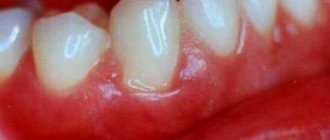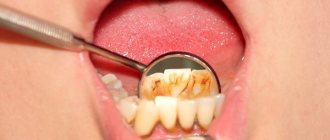Antibacterial compounds play an important role in maintaining oral hygiene. They are necessary to destroy bacteria and reduce pain. A solution of soda, salt and iodine is by far the safest and most affordable means of preventing many dental diseases. Rinsing helps to cope with aching, acute pain, and in some cases even relieve swelling near the gum pocket.
Sodium bicarbonate has many positive properties. Its use prevents the development of carious manifestations and inhibits pathological processes. You can even remove tartar using baking soda powder. Quite often they rinse their mouth with soda after resection of an element of the dentition has been performed or nerve endings have been painfully removed. Antibacterial compounds accelerate the regeneration of soft tissues and have a disinfecting effect.
Indications for rinsing with a solution of soda and salt
As a preventive procedure, it is recommended to rinse with sodium bicarbonate, as this has the necessary antimicrobial effect. The main indications for rinsing with soda and salt in the required proportions:
- Dental diseases. Gingivitis, stomatitis, periodontal disease and other pathologies in which the gum canal is damaged.
- Hygienic. Aimed at removing food debris and plaque from hard-to-reach areas.
- Therapeutic and prophylactic. Rinsing your mouth with soda can also be done as a preventative measure.
All therapeutic rinses must be performed only after consultation with a doctor. Only a dentist can determine whether in your case it is possible to rinse your mouth with soda, salt and iodine. This procedure has certain contraindications, so improper use can lead to deterioration of health and significant harmful effects.
Important rules for treatment
During treatment you should follow several tips:
- Flux cannot be cured by rinsing alone;
- It is not recommended to prepare the rinse in advance, and the prepared solution should be used at a time;
- you cannot increase the dosage of the drug, you must strictly follow the prescription so as not to cause harm;
- water for use should be warm, not hot;
- sodium bicarbonate should be added immediately to warm water, not to boiling water and cooled;
- You should not drink or eat food for at least half an hour after the procedure.
Sodium bicarbonate is a universal remedy that has no contraindications. But there are still cases when its use is prohibited:
- You cannot rinse the mouth of a small child with a soda solution, as he does not yet know how to spit out the liquid and may swallow the product.
- You should not use baking soda immediately after surgery or tooth extraction, as rinsing prevents the formation of a blood clot, which is necessary to protect the wound.
- It is not recommended to use this remedy for stomach ulcers.
Recommended for you:
How to rinse your mouth with soda correctly, solution recipe, proportions, what it helps with
Following these recommendations, the treatment will proceed without complications.
Types of rinsing solutions
Soda. Sodium bicarbonate has a good antifungal effect, soda is effective as a prophylaxis against gum inflammation. It is recommended to add a teaspoon of the chemical element to a glass of warm boiled water. The advantages of the solution include the fact that it gently cleanses the oral cavity and tooth enamel and has a good disinfectant effect.- Salt. Saline solution is a good antiseptic. To prepare, dilute a spoonful of salt in a glass of warm water. Salt promotes rapid healing of cracks and wounds, soothes the diseased element of the dental system.
- Soda-salt. The use of soda-salt solution is the most effective therapeutic and preventive method. In this case, mix a teaspoon of soda and salt in a glass of warm water. The best option when the first symptoms of various dental pathologies appear.
- Soda-salt with iodine. An indispensable assistant in solving various dental problems. It is necessary to rinse your mouth with iodine, salt and soda in the right proportions. Half a teaspoon of soda and salt and a drop of iodine are diluted in warm water. Everything is thoroughly mixed. It is used as a prophylaxis for bleeding gums and for the treatment of all kinds of inflammatory processes.
We looked at how you can make soda-salt baths using various additional components. Today there is a wide variety of solutions, but it is necessary to consult a specialist. Following the doctor’s recommendations will help prevent drying of the mucous membrane, increased sensitivity of the enamel and other negative phenomena.
Main causes and symptoms of the disease
The main reasons for the development of the disease include the following:
- failure to comply with oral hygiene rules,
- development of caries,
- development of a cyst at the root of the tooth,
- inflammation of the gums,
- hypothermia,
- mechanical damage to teeth and gums.
Due to the penetration of infection, the connective tissues around the teeth become inflamed and softened. During further penetration, severe pain may occur. This pain can be caused by inflammation of the nerves of the tooth. Even if the pain subsides over time, this does not mean that the infection has gone away, it simply begins to penetrate deeper and affects the root of the tooth, which causes swelling of the gums.
Before treating flux with soda, you must make sure the diagnosis is correct. To do this you need to know the symptoms of the disease. The following symptoms occur with this disease:
- swelling of the periosteum,
- seal on the gum,
- a lump filled with pus,
- swelling in the eye area,
- heat,
- increase in facial nodes.
It is very important that if you notice the above symptoms, contact your doctor immediately and begin emergency treatment. At home, soda can serve as first aid for flux.
The first cause of gumboil is dental caries. First, an infection gets into a tooth affected by caries, then inflammation appears, often purulent. If you don’t go to the dentist in time and don’t treat the aching tooth, you risk developing gumboil - the pus, trying to get out of the tooth cavity, penetrates under the bone.
Caries is not the only cause of gumboil - it can also be injury or inflammation of the space between the tooth and gum. In this case, flux is formed in the same way as with caries.
How to rinse with baking soda correctly
It is recommended to follow these simple guidelines:
- Hygiene. Thoroughly clean the elements of the dental system from dirt and food debris.
- Temperature conditions. It is recommended to use cooled boiled water, as boiling water can cause injury to the gum tissue, and too cool water can lead to discomfort.
- Features of rinsing. It is necessary to keep the solution exactly in the place where the pain is localized.
- Interval. It is necessary to rinse your mouth with soda, salt and iodine at least three times a day, in some cases more often depending on the doctor’s recommendations. The procedure itself should last from 3 to 6 minutes.
If you don’t know what to rinse your mouth with or how to prepare the solution, consult your doctor. This is especially important to do if you have an allergic reaction to sodium bicarbonate or have any contraindications. As prescribed by a doctor, a decoction of chamomile, oak bark or sage can be prescribed.
Symptoms of tooth inflammation under the crown
Inflammatory processes in the dental system are accompanied by pain, swelling, hyperemia of the gums, abscesses and other symptoms, depending on the clinical case. In severe cases of the disease, headaches, sleep disturbances, increased body temperature, irritability, and weakness are possible.
Signs of inflammation:
- Pain in the tooth under the crown. An acute symptom indicates the presence of a serous or purulent focus of inflammation near the dental unit. Purulent formations put pressure on neighboring tissues, so pain is felt all the time. If it is short-term and occurs only when pressing on the prosthesis or during chewing, then the pathology occurs in a chronic, but no less dangerous form.
- Tooth cyst under the crown. Appears at the root tips as a complication of the inflammatory process in the periodontium or root canals. First, a granuloma forms. As it grows, it becomes covered with a dense membrane, transforming into a sac containing bacteria, dead cells and pus. Gradually grows in size, causing pain and swelling of the gums. It can break through at any moment and lead to the development of more severe conditions and pathologies.
- Gum tumor, gumboil under the crown. Symptoms also indicate problems in the periodontium and at the root tips. Often, not only the mucous membranes swell, but also part of the face in the projection of the source of inflammation. The tooth and neighboring units on this side are aching. The doctor determines the exact location from the image. If flux occurs, the purulent cavity is opened, cleaned and drainage is installed.
- Fistula under the crown. Pathology develops due to lack of treatment in the initial stages of inflammation. The purulent masses increase in volume and a fistula canal is formed for their outflow. It’s good if it appears in the gums and becomes noticeable; in the worst case, the pus goes deeper and affects the jaw bones, causing osteomyelitis. After the formation of a fistula, the pain subsides as the pressure decreases, but the pathological masses enter the body along with saliva and poison it. After a while, the hole contracts and the whole process is repeated until a new fistula appears.
Any symptom indicated is a reason to visit a dental clinic. Treatment is prescribed after examining the patient and conducting instrumental diagnostics.
Rinsing teeth with soda: benefits and harms
A properly prepared solution has an antimicrobial effect and helps prevent the pathological process associated with the destruction of enamel, dentin, and pulp chamber. It relieves pain, reduces the severity of the inflammatory process, and can be used to whiten teeth. Its use as a prophylactic agent will help make tooth pain weaker and the patient’s condition much more comfortable.
In some cases, the soda-saline solution should be abandoned. For example, in cases of thyroid dysfunction, nephritis and tuberculosis, the use of iodine is contraindicated; this also applies to cases of lactation and pregnancy. More complete information about contraindications can be obtained by talking to a specialist.
It must be emphasized that soda and salt can be used in complex therapy only as a preventive measure. If the pain does not go away and throbbing pain is diagnosed, you should immediately visit a doctor. Specialists of the Alpha Dent clinic are ready to provide high-quality dental services and advise on the use of soda solutions. The right approach will allow you to achieve the desired effect and avoid complications.
How to recognize periostitis
The most striking signs of gumboil are swelling and throbbing pain in the area of inflammation, which intensifies with pressure on the tooth. Over time, pain does not respond to painkillers, the cheek and jaw swell due to inflammation, the gums become red, pain can radiate to the eye, ear or throat (difficulty swallowing, turning the neck), body temperature rises, lymph nodes enlarge, weakness in the body is felt .
Causes of inflammation:
- neglected or untreated caries is the most common cause;
- dental intervention - flux after tooth extraction, poor quality treatment;
- sinusitis;
- angina;
- hypothermia;
- infections and injuries of teeth and gums;
- insufficient hygiene;
- Oral diseases - periodontitis, pulpitis, gingivitis and others.
Features of periostitis and causes of its occurrence
The appearance of flux is associated with the development of a severe inflammatory process with:
- penetration of infection from the carious cavity into the pulp;
- accumulation of pathogenic microorganisms in dental pockets;
- dental injuries;
- improper oral hygiene or its complete absence.
Accumulations of soft plaque on the surface of the gingival edge of the tooth or hard dental deposits become food for pathogenic microbes, the accumulated waste products of which cause the development of inflammation and the appearance of an abscess.
During the course of the disease, swelling of the gums and buccal mucosa appears, and external manifestations in the form of swelling and hyperemia of tissues are possible. Depending on the location of the source of inflammation, swelling spreads to the area of the eyes, chin, and neck. The process affects the submandibular lymph nodes, which leads to their severe pain. The lack of effective timely treatment of flux leads to the spread of pus into the maxillary sinuses, periosteum or jaw bones.
Treatment can only be prescribed by a qualified dentist, and even with successful therapy at home, a visit to the doctor cannot be avoided. The choice of therapeutic measures is related to the characteristics of the inflammatory process, the degree of its development and the reason why odontogenic periostitis occurred.
The lack of qualified medical care leads to a cavity filled with purulent contents appearing at the apex of the affected tooth root. It is this that accumulates that leads to the appearance of flux, swelling, pain, and penetration of infection into the periosteum and bone tissue. In this case, treatment can only be surgical, with an incision, removal of pus and extraction of the diseased tooth.
Hoping that everything will “go away on its own,” we don’t even think about the fact that the result of heroic long-suffering in this case could be gumboil.
However, there is a method that will help stop the development of inflammation, relieve swelling, and eliminate the source of infection. The main thing is to start treatment on time, and then regular rinsing with specially prepared compounds will help cope with the disease.











